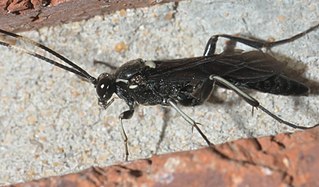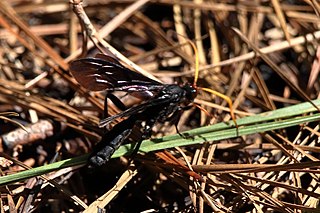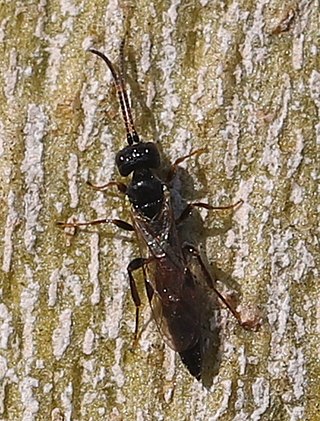
The Ichneumonidae, also known as ichneumon wasps, ichneumonid wasps, ichneumonids, or Darwin wasps, are a family of parasitoid wasps of the insect order Hymenoptera. They are one of the most diverse groups within the Hymenoptera with roughly 25,000 species described as of 2016. However, this likely represents less than a quarter of their true richness as reliable estimates are lacking, along with much of the most basic knowledge about their ecology, distribution, and evolution. It is estimated that there are more species in this family than there are species of birds and mammals combined. Ichneumonid wasps, with very few exceptions, attack the immature stages of holometabolous insects and spiders, eventually killing their hosts. They thus fulfill an important role as regulators of insect populations, both in natural and semi-natural systems, making them promising agents for biological control.

The Braconidae are a family of parasitoid wasps. After the closely related Ichneumonidae, braconids make up the second-largest family in the order Hymenoptera, with about 17,000 recognized species and many thousands more undescribed. One analysis estimated a total between 30,000 and 50,000, and another provided a narrower estimate between 42,000 and 43,000 species.

Banchinae is a subfamily of ichneumonid parasitoid wasps containing about 1,500 species; the genera Glypta and Lissonota are very large. The three tribes are all distributed worldwide.

Xoridinae are a worldwide subfamily of the parasitic wasp family Ichneumonidae.

Acaenitinae is a subfamily of the parasitoid wasp family Ichneumonidae. Female Acaenitinae have a large triangular projecting genital plate.

The Labeninae is a subfamily within the parasitoid wasp family Ichneumonidae. The family is divided into 12 extant genera grouped within four tribes.
John Frederick Perkins FRES was an English entomologist. He was the son of Zoë Lucy Sherrard Alatau and Robert Cyril Layton Perkins, also a hymenopterist. He was first educated at Newton College (Devon) and graduated with a First class Honours degree from the Imperial College of Science and Technology in 1932. In 1933, he was appointed an Assistant Keeper in the Department of Entomology British Museum where he specialised in Hymenoptera.
Gerd Hermann Heinrich was a German entomologist and ornithologist known for his studies of parasitic Hymenoptera of the Ichneumonidae family and for the description of several bird species in Celebes, Dutch East Indies.

Amblyteles armatorius is a species of parasitic wasp in the family Ichneumonidae first described by Johann Reinhold Forster in 1771.

Idiogramma comstockii is a species of wasp.

Trogus is a genus of parasitoid wasp found in the Holarctic and Neotropic regions. It is placed in the subfamily Ichneumoninae and the tribe Ichneumonini. Trogus species are parasites of larvae and pupae of the swallowtail butterfly family, Papilionidae. The genus consists of twelve extant and one extinct species.

Ichneumonini is a tribe of ichneumon wasps in the family Ichneumonidae. There are more than 350 genera and thousands of described species in Ichneumonini.

Limonethe is a genus of ichneumon wasps in the family Ichneumonidae. There are about five described species in Limonethe. They can be distinguished from similar genera based on the nearly square-shaped areolet and the large and dense punctures on the post-petiole. Many also have infuscated wings, a red abdomen, black head and mesosoma with narrow white markings along the inner eye margins. Limonethe occurs in the New World from Canada to Argentina.

Aoplus is a genus of insects belonging to the family Ichneumonidae.

Diphyus is a genus of parasitoid wasps belonging to the family Ichneumonidae.

Gnamptopelta obsidianator is a species of wasp in the family Ichneumonidae and the only species in the monotypic genus Gnamptopelta.
Alomyini is a tribe of ichneumon wasps in the family Ichneumonidae. There are two genera in Alomyini.

Phaeogenini is a tribe of ichneumon wasps in the family Ichneumonidae.

Platylabini is a tribe of ichneumon wasps in the family Ichneumonidae. There are at least 40 genera and about 8 described species in Platylabini.

Listrodromus nycthemerus, the holly blue Darwin wasp, is a species of ichneumon wasp belonging to the family Ichneumonidae. This species is a parasitoid, its sole host species being the holly blue butterfly.


















